D412硫化橡胶和热塑性弹性体拉伸试验方法
橡胶材料的拉伸性能测试方法

橡胶材料的拉伸性能测试方法橡胶材料是一种常见且重要的材料,在各种工业领域中得到广泛应用。
为了保证橡胶制品的质量和可靠性,对其拉伸性能进行准确的测试是十分重要的。
本文将介绍几种常用的橡胶材料拉伸性能测试方法,以供参考。
一、拉伸性能测试的目的和意义拉伸性能测试是评估橡胶材料在拉伸加载下的力学性能的一种方法。
通过测试可以了解橡胶材料的拉伸强度、断裂伸长率、弹性模量等重要参数,以评估橡胶材料在实际使用中的可靠性和耐久性。
对于不同类型和用途的橡胶制品,其拉伸性能要求也不同,因此选择合适的测试方法对于保证产品质量至关重要。
二、常用的拉伸性能测试方法1. 标准拉伸试验方法标准拉伸试验方法是最常用且被广泛采用的一种测试方法。
该方法通常使用万能材料试验机进行测试,将橡胶试样置于夹具之间,并施加均匀的拉伸力。
通过测量加载力和试样的伸长量,可以计算出拉伸强度、断裂伸长率等参数。
这种方法操作简单、可重复性好,被广泛应用于橡胶材料的质量控制和研发过程中。
2. 维卡软材料试验方法维卡(Wickham)软材料试验方法是一种用于测量弹性橡胶材料的应力-应变行为的方法。
该方法通过施加恒定的应变速率并测量应力的变化,绘制出应力-应变曲线。
通过分析曲线的斜率和形状可以得到各种力学参数,如初始刚度、最大应力等。
维卡试验方法适用于测试橡胶材料的非线性力学行为,尤其是在低应变范围下。
3. 动态力学分析方法动态力学分析方法是利用动态力学分析仪器,例如DMA (Dynamic Mechanical Analyzer)进行的测试方法。
DMA可以在不同的温度、频率和应变条件下进行测试,得到橡胶材料的动态力学特性。
通过测量橡胶的储存模量、损耗模量和相位角等参数,可以得到材料的刚度、阻尼和能量耗散性能。
这种方法适用于评估橡胶材料的动态性能和耐久性,特别是在高温或低温条件下。
三、拉伸性能测试的操作步骤无论采用何种方法,进行拉伸性能测试都需要遵循以下一般操作步骤:1. 准备试样:按照相关标准或要求,制备符合尺寸要求的试样,并在试样上标明相关信息。
ASTMD412硫化橡胶和热塑性弹性体拉伸试验方法

ASTMD412硫化橡胶和热塑性弹性体拉伸试验方法试样的制备是ASTMD412试验的第一步。
根据标准规定,试样是通过轮廓刀或模具从材料中剪切得到的。
试样的形状可以是圆形、矩形或带状,具体尺寸和形状应符合标准要求。
在进行拉伸试验之前,试样应先进行热处理。
这是为了消除内部应力和降低试样的应变率。
热处理的条件包括温度和时间,具体取决于材料的类型和特性。
标准要求在140°C的恒温槽中热处理试样。
拉伸试验仪是进行ASTM D412试验的关键设备。
该设备通常包括一个固定夹具和一个可移动夹具,试样被夹在两个夹具之间。
试样应在标准规定的环境条件下进行拉伸,常见的测试速度是500 mm/min。
在试验期间,试样的拉伸行为将会监测并记录下来。
试验中最重要的参数是载荷和延伸度。
载荷是材料抵抗拉伸的力,延伸度是试样在拉伸过程中的变形程度。
这些参数将用来计算材料的拉伸强度、延伸率以及应变硬化指数等。
通过ASTMD412试验,可以评估材料的拉伸性能。
拉伸强度是材料抵抗拉伸的能力,是在试样断裂前所能达到的最大载荷。
延伸率是测量试样在拉伸过程中的变形程度,可以衡量弹性和延展性。
应变硬化指数是衡量材料的应变硬化能力,可以确定材料的形变能力。
总之,ASTMD412试验方法是一种用于评估硫化橡胶和热塑性弹性体拉伸性能的标准方法。
通过该方法,可以获得材料在拉伸应力下的延伸性、弹性和破坏性能。
这些数据可以用来进行材料性能评估和比较,并用于优化材料设计和应用。
ASTMD412

Specimens may be in the shape of dumbbells,rings or straight pieces of uniform cross-sectional area.4.2Measurements for tensile stress,tensile stress at a given elongation,tensile strength,yield point,and ultimate elonga-tion are made on specimens that have not been prestressed. Tensile stress,yield point,and tensile strength are based on the original cross-sectional area of a uniform cross-section of the specimen.4.3Measurement of tensile set is made after a previously unstressed specimen has been extended and allowed to retract by a prescribed procedure.Measurement of“set after break”is also described.5.Significance and Use5.1All materials and products covered by these test meth-ods must withstand tensile forces for adequate performance in certain applications.These test methods allow for the measure-ment of such tensile properties.However,tensile properties alone may not directly relate to the total end use performance of the product because of the wide range of potential perfor-mance requirements in actual use.5.2Tensile properties depend both on the material and the conditions of test(extension rate,temperature,humidity,speci-men geometry,pretest conditioning,etc.);therefore materials should be compared only when tested under the same condi-tions.5.3Temperature and rate of extension may have substantial effects on tensile properties and therefore should be controlled. These effects will vary depending on the type of material being tested.5.4Tensile set represents residual deformation which is partly permanent and partly recoverable after stretching and retraction.For this reason,the periods of extension and recovery(and other conditions of test)must be controlled to obtain comparable results.6.Apparatus6.1Testing Machine—Tension tests shall be made on a power driven machine equipped to produce a uniform rate of grip separation of500650mm/min(2062in./min)for a distance of at least750mm(30in.)(see Note1).The testing machine shall have both a suitable dynamometer and an indicating or recording system for measuring the applied force within62%.If the capacity range cannot be changed for a test (as in the case of pendulum dynamometers)the applied force at break shall be measured within62%of the full scale value, and the smallest tensile force measured shall be accurate to within10%.If the dynamometer is of the compensating type for measuring tensile stress directly,means shall be provided to adjust for the cross-sectional area of the specimen.The response of the recorder shall be sufficiently rapid that the applied force is measured with the requisite accuracy during the extension of the specimen to rupture.If the testing machine is not equipped with a recorder,a device shall be provided that indicates,after rupture,the maximum force applied during extension.Testing machine systems shall be capable of mea-suring elongation of the test specimen in minimum increments of10%.N OTE2—A rate of elongation of10006100mm/min(4064in./min)may be used and notation of the speed made in the report.In case of dispute,the test shall be repeated and the rate of elongation shall be at500 650mm/min(2062in./min).6.2Test Chamber for Elevated and Low Temperatures—The test chamber shall conform with the following requirements: 6.2.1Air shall be circulated through the chamber at a velocity of1to2m/s(3.3to6.6ft/s)at the location of the grips or spindles and specimens maintained within2°C(3.6°F)of the specified temperature.6.2.2A calibrated sensing device shall be located near the grips or spindles for measuring the actual temperature.6.2.3The chamber shall be vented to an exhaust system or to the outside atmosphere to remove fumes liberated at high temperatures.6.2.4Provisions shall be made for suspending specimens vertically near the grips or spindles for conditioning prior to test.The specimens shall not touch each other or the sides of the chamber except for momentary contact when agitated by the circulating air.6.2.5Fast acting grips suitable for manipulation at high or low temperatures may be provided to permit placing dumbbells or straight specimens in the grips in the shortest time possible to minimize any change in temperature of the chamber.6.2.6The dynamometer shall be suitable for use at the temperature of test or it shall be thermally insulated from the chamber.6.2.7Provision shall be made for measuring the elongation of specimens in the chamber.If a scale is used to measure the extension between the bench-marks,the scale shall be located parallel and close to the grip path during specimen extension and shall be controlled from outside the chamber.6.3Dial Micrometer—The dial micrometer shall conform to the requirements of Practice D3767(Method A).For ring specimens,see14.10of these test methods.6.4Apparatus for Tensile Set Test—The testing machine described in6.1or an apparatus similar to that shown in Fig.1 may be used.A stop watch or other suitable timing device measuring in minute intervals for at least30min,shall be provided.A scale or other device shall be provided for measuring tensile set to within1%.7.Selection of Test Specimens7.1Consider the following information in making selec-tions:7.1.1Since anisotropy or grain directionality due toflow introduced during processing and preparation may have an influence on tensile properties,dumbbell or straight specimens should be cut so the lengthwise direction of the specimen is parallel to the grain direction when this direction is known. Ring specimens normally give an average of with and across the grain properties.7.1.2Unless otherwise noted,thermoplastic rubber or ther-moplastic elastomer specimens,or both,are to be cut from injection molded sheets or plaques with a thickness of3.06 0.3mm.Specimens of other thickness will not necessarily give comparable results.Specimens are to be tested in directions both parallel and perpendicular to the direction offlow in the mold.Sheet or plaque dimensions must be sufficient to do this.7.1.3Ring specimens enable elongations to be measuredbygrip separation,but the elongation across the radial width ofthe ring specimens is not uniform.To minimize this effect thewidth of the ring specimens must be small compared to thediameter.7.1.4Straight specimens tend to break in the grips if normalextension-to-break testing is conducted and should be usedonly when it is not feasible to prepare another type ofspecimen.For obtaining non-rupture stress-strain or materialmodulus properties,straight specimens are quite useful.7.1.5The size of specimen type used will be determined bythe material,test equipment and the sample or piece availablefor test.A longer specimen may be used for rubbers having lowultimate elongation to improve precision of elongation mea-surement.8.Calibration of the Testing Machine 8.1Calibrate the testing machine in accordance with Proce-dure A of Practice E 4.If the dynamometer is of the strain-gage type,calibrate the tester at one or more forces in addition to the requirements in Sections 7and 18of Practice E 4.Testers having pendulum dynamometers may be calibrated as follows:8.1.1Place one end of a dumbbell specimen in the upper grip of the testing machine.8.1.2Remove the lower grip from the machine and attach it,by means of the gripping mechanism to the dumbbell specimen in the upper grip.8.1.3Attach a hook to the lower end of the lower specimen grip mechanism.8.1.4Suspend a known mass from the hook of thelowerFIG.1Apparatus for Tensile SetTestspecimen grip mechanism in such a way as to permit the mass assembly to temporarily rest on the lower testing machine grip framework or holder(see Note2).8.1.5Start the grip separation motor or mechanism,as in normal testing,and allow it to run until the mass is freely suspended by the specimen in the upper grip.8.1.6If the dial or scale does not indicate the force applied (or its equivalent in stress for a compensating type tester) within specified tolerance,thoroughly inspect the testing ma-chine for malfunction(for example,excess friction in bearings and other moving parts).Ensure that the mass of the lower grip mechanism and the hook are included as part of the known mass.8.1.7After machine friction or other malfunction has been removed,recalibrate the testing machine at a minimum of three points using known masses to produce forces of approximately 10,20and50%of capacity.If pawls or rachets are used during routine testing,use them for calibration.Check for friction in the head by calibrating with the pawls up.N OTE3—It is advisable to provide a means for preventing the known mass from falling to thefloor in case the dumbbell should break.8.2A rapid approximate calibration of the testing machine may be obtained by using a spring calibration device.9.Test Temperature9.1Unless otherwise specified,the standard temperature for testing shall be2362°C(73.463.6°F).Specimens shall be conditioned for at least3h when the test temperature is23°C (73.4°F).If the material is affected by moisture,maintain the relative humidity at5065%and condition the specimens for at least24h prior to testing.When testing at any other temperature is required use one of the temperatures listed in Practice D1349.9.2For testing at temperatures above23°C(73.4°F)preheat specimens for1062min for Method A and for662min for Method B(see Note3).Place each specimen in the test chamber at intervals ahead of testing so that all specimens of a series will be in the chamber the same length of time.The preheat time at elevated temperatures must be limited to avoid additional vulcanization or thermal aging.N OTE4—Precaution:In addition to other precautions,suitable heat or cold resistant gloves should be worn for arm and hand protection when testing at other than23°C(73.4°F).A mask for the face is very desirable for high temperature testing to prevent the inhalation of toxic fumes when the door of the chamber is open.9.3For testing at temperatures below23°C(73.4°F)condi-tion the specimens at least10min prior to testing.TEST METHOD A—DUMBBELL AND STRAIGHTSPECIMENS10.Apparatus10.1Die—The shape and dimensions of the die for prepar-ing dumbbell specimens shall conform with those shown in Fig. 2.The inside faces in the reduced section shall be perpendicular to the plane formed by the cutting edges and polished for a distance of at least5mm(0.2in.)from the cutting edge.The die shall at all times be sharp and free of nicks(see Note4).N OTE5—The condition of the die may be determined by investigating the rupture point on any series of broken(ruptured)specimens.Remove such specimens from the grips of the testing machine,stack the joined-together specimens on top of each other,and note if there is any tendency for tensile breaks to occur at the same position on each of the specimens. Rupture consistently at the same place indicates that the die may be dull, nicked,or bent at that location.10.2Bench Marker—The two marks placed on the speci-men and used to measure elongation or strain are called“bench marks”(see Note5).The bench marker shall consist of a base plate containing two raised parallel projections.The surfaces of the raised projections(parallel to the plane of the base plate) are ground smooth in the same plane.The raised projection marking surfaces shall be between0.05and0.08mm(0.002 and0.003in.)wide and at least15mm(0.6in.)long.The angles between the parallel marking surfaces and the sides of the projections shall be at least75°.The distance between the centers of the two parallel projections or marking surfaces shall be within1%of the required or target bench mark distance.A handle attached to the back or top of the bench marker base plate is normally a part of the bench marker.N OTE6—If a contact extensometer is used to measure elongation, bench marks are not necessary.10.3Ink Applicator—Aflat unyielding surface(hardwood, metal,or plastic)shall be used to apply either ink or powder to the bench marker.The ink or powder shall adhere to the specimen,have no deteriorating effect on the specimen and be of contrasting color to that of the specimen.10.4Grips—The testing machine shall have two grips,one of which shall be connected to the dynamometer.10.4.1Grips for testing dumbbell specimens shall tighten automatically and exert a uniform pressure across the gripping surfaces,increasing as the tension increases in order to prevent slippage and to favor failure of the specimen in the straight reduced section.Constant pressure pneumatic type grips also are satisfactory.At the end of each grip a positioning device is recommended for inserting specimens to the same depth in the grip and for alignment with the direction of pull.10.4.2Grips for testing straight specimens shall be constant pressure pneumatic,wedged,or toggle type designed to trans-mit the applied gripping force over the entire width of the gripped specimen.11.Specimens11.1Dumbbell Specimens—Whenever possible,the test specimens shall be injection molded or cut from aflat sheet not less than1.3mm(0.05in.)nor more than3.3mm(0.13in.) thick and of a size which will permit cutting a specimen by one of the standard methods(see Practice D3182).Sheets may be prepared directly by processing or fromfinished articles by cutting and buffing.If obtained from a manufactured article, the specimen shall be free of surface roughness,fabric layers, etc.in accordance with the procedure described in Practice D3183.All specimens shall be cut so that the lengthwise portion of the specimens is parallel to the grain unless otherwise specified.In the case of sheets prepared in accor-dance with Practice D3182,the specimen shall be2.060.2 mm(0.0860.008in.)thick died out in the direction of the e Die C,Fig.2(unless otherwise noted)to cutthespecimens from the sheet with a single impact stroke (hand ormachine)to ensure smooth cut surfaces.11.1.1Marking Dumbbell Specimens —Dumbbell speci-mens shall be marked with the bench marker described in 10.2,with no tension on the specimens at the time of marking.Marksshall be placed on the reduced section,equidistant from itscenter and perpendicular to the longitudinal axis.The betweenbench mark distance shall be as follows:for Die C or Die D ofFig.2,25.0060.25mm (1.0060.01in.);for any other Dieof Fig.2,50.0060.5mm (2.0060.02in.).11.1.2Measuring Thickness of Dumbbell Specimens —Three measurements shall be made for the thickness,one at thecenter and one at each end of the reduced section.The medianof the three measurements shall be used as the thickness incalculating the cross sectional area.Specimens with a differ-ence between the maximum and the minimum thickness exceeding 0.08mm (0.003in.),shall be discarded.The width of the specimen shall be taken as the distance between the cutting edges of the die in the restricted section.11.2Straight Specimens —Straight specimens may be pre-pared if it is not practical to cut either a dumbbell or a ring specimen as in the case of a narrow strip,small tubing or narrow electrical insulation material.These specimens shall be of sufficient length to permit their insertion in the grips used for the test.Bench marks shall be placed on the specimens as described for dumbbell specimens in 11.1.1.To determine the cross sectional area of straight specimens in the form of tubes,the mass,length,and density of the specimen may be required.The cross sectional area shall be calculated from these mea-surements asfollows:FIG.2Standard Dies for Cutting DumbbellSpecimensA 5M /DL (1)where:A =cross-sectional area,cm 2,M =mass,g,D =density,g/cm 3,and L =length,cm.N OTE 7—A in square inches =A (cm 2)30.155.12.Procedure12.1Determination of Tensile Stress,Tensile Strength andYield Point —Place the dumbbell or straight specimen in thegrips of the testing machine,using care to adjust the specimensymmetrically to distribute tension uniformly over the crosssection.This avoids complications that prevent the maximumstrength of the material from being evaluated.Unless otherwisespecified,the rate of grip separation shall be 500650mm/min(2062in./min)(see Note 7).Start the machine and note thedistance between the bench marks,taking care to avoidparallax.Record the force at the elongation(s)specified for thetest and at the time of rupture.The elongation measurement ismade preferably through the use of an extensometer,anautographic mechanism or a spark mechanism.At rupture,measure and record the elongation to the nearest 10%.SeeSection 13for calculations.N OTE 8—For materials having a yield point (yield strain)under 20%elongation when tested at 500650mm/min (2062in./min),the rate ofelongation shall be reduced to 5065mm/min (2.060.2in./min).If thematerial still has a yield point (strain)under 20%elongation,the rate shall be reduced to 560.5mm/min (0.260.002in./min).The actual rate of separation shall be reported.12.2Determination of Tensile Set —Place the specimen in the grips of the testing machine described in 6.1or the apparatus shown in Fig.1,and adjust symmetrically so as to distribute the tension uniformly over the cross section.Sepa-rate the grips at a rate of speed as uniformly as possible,that requires 15s to reach the specified elongation.Hold the specimen at the specified elongation for 10min,release quickly without allowing it to snap back and allow the specimen to rest for 10min.At the end of the 10min rest period,measure the distance between the bench marks to the nearest 1%of the original between bench mark e a stop watch for the timing operations.See Section 13for calculations.12.3Determination of Set-After-Break —Ten minutes after a specimen is broken in a normal tensile strength test,carefully fit the two pieces together so that they are in good contact over the full area of the break.Measure the distance between the bench marks.See Section 13for calculations.13.Calculation 13.1Calculate the tensile stress at any specified elongation as follows:T ~xxx !5F ~xxx !/A (2)where:Dimensions of Standard Dumbbell Dies A (Metric Units)DimensionUnits Tolerance Die A Die B Die C Die D Die E Die F Amm 61252525161616Bmm max 404040303030Cmm min 140140115100125125Dmm 66B 323232323232D-Emm 61131313131313Fmm 62383819193838Gmm 61141414141414Hmm 62252525161616Lmm 62595933335959Wmm 60.05,–0.001266336Zmm 61131313131313A Dies whose dimensions are expressed in metric units are not exactly the same as dies whose dimensions are expressed in U.S.customary units.Dies dimensioned in metric units are intended for use with apparatus calibrated in metric units.B For dies used in clicking machines it is preferable that this tolerance be 60.5mm.FIG.2a (continued)Dimensions of Standard Dumbbell Dies A (U.S.Customary Units)DimensionUnits Tolerance Die A Die B Die C Die D Die E Die F Ain.60.041110.620.620.62Bin.max 1.6 1.6 1.6 1.2 1.2 1.2Cin.min 5.5 5.5 4.5455Din.60.25B 1.25 1.25 1.25 1.25 1.25 1.25D-Ein.60.040.50.50.50.50.50.5Fin.60.08 1.5 1.50.750.75 1.5 1.5Gin.60.040.560.560.560.560.560.56Hin.60.081110.630.630.63Lin.60.08 2.32 2.32 1.31 1.31 2.32 2.32Win.60.002,–0.0000.5000.2500.2500.1250.1250.250Zin.60.040.50.50.50.50.50.5ADies whose dimensions are expressed in metric units are not exactly the same as dies whose dimensions are expressed in U.S.customary units.B For dies used in clicking machines it is preferable that this tolerance by 60.02in.FIG.2b(continued)T(xxx)=tensile stress at(xxx)%elongation,MPa(lbf/ in.2),F(xxx)=force at specified elongation,MN or(lbf),andA=cross-sectional area of unstrained specimen,m2 (in.2).13.2Calculate the yield stress as follows:Y~stress!5F~y!/A(3) where:Y(stress)=yield stress,that stress level where the yield point occurs,MPa(lbf/in.2),F(y)=magnitude of force at the yield point,MN(lbf), andA=cross-sectional area of unstrained specimen,m2 (in.2).13.3Evaluate the yield strain as that strain or elongation magnitude,where the rate of change of stress with respect to strain,goes through a zero value.13.4Calculate the tensile strength as follows:TS5F~BE!/A(4) where:TS=tensile strength,the stress at rupture,MPa(lbf/ in.2),F(BE)=the force magnitude at rupture,MN(lbf),andA=cross-sectional area of unstrained specimen,m2 (in.2).13.5Calculate the elongation(at any degree of extension)as follows:E5100@L–L~o!#/L~o!(5) where:E=the elongation in percent(of original bench mark distance),L=observed distance between bench marks on the extended specimen,andL(o)=original distance between bench marks(use same units for L and L(o)).13.6The breaking or ultimate elongation is evaluated when L is equal to the distance between bench marks at the point of specimen rupture.13.7Calculate the tensile set,by using Eq5,where L is equal to the distance between bench marks after the10min retraction period.13.8Test Result—A test result is the median of three individual test measurement values for any of the measured properties as described above,for routine testing.There are two exceptions to this and for these exceptions a total offive specimens(measurements)shall be tested and the test result reported as the median offive.13.8.1Exception1—If one or two of the three measured values do not meet specified requirement values when testing for compliance with specifications.13.8.2Exception2—If referee tests are being conducted.TEST METHOD B—CUT RING SPECIMENS 14.Apparatus14.1Cutter—A typical ring cutter assembly is illustrated in Fig. 3.This is used for cutting rings fromflat sheets by mounting the upper shaft portion of the cutter in a rotating housing that can be lowered onto a sheet held by the rubber holding plate as shown in Fig.4.14.1.1Blade Depth Gage—This gage consists of a cylin-drical disk having a thickness of at least0.5mm(0.02in.) greater than the thickness of the rubber to be cut and a diameter less than the inside diameter of the specimen used for adjusting the protrusion of the blades from the body of the cutter.See Fig.3.14.2Rubber Holding Plate—The apparatus for holding the sheet during cutting shall have plane parallel upper and lower surfaces and shall be a rigid polymeric material(hard rubber, polyurethane,polymethylmethacrylate)with holes approxi-mately1.5mm(0.06in.)in diameter spaced6or7mm(0.24 or0.32in.)apart across the central region of the plate.All the holes shall connect to a central internal cavity which can be maintained at a reduced pressure for holding the sheet in place due to atmospheric pressure.Fig.4illustrates the design of an apparatus for holding standard sheets(approximately1503 15032mm)during cutting.14.3Source of Reduced Pressure—Any device such as a vacuum pump that can maintain an absolute pressure below10 kPa(0.1atm)in the holding plate central cavity.14.4Soap Solution—A mild soap solution shall be used on the specimen sheet to lubricate the cutting blades.14.5Cutter Rotator—A precision drill press or other suit-able machine capable of rotating the cutter at an angular speed of at least30rad/s(approximately300r/min)during cutting shall be used.The cutter rotator device shall be mounted on a horizontal base and have a vertical support orientation for the shaft that rotates the spindle and cutter.The run-out of the rotating spindle shall not exceed0.01mm(0.004in.).14.6Indexing Table—A milling table or other device with typical x-y motions shall be provided for positioning the sheet and holder with respect to the spindle of the cutter rotating device.14.7Tensile Testing Machine—A machine as specified in 6.1shall be provided.14.8Test Fixture—A testfixture as shown in Fig.5shall be provided for testing the ring specimens.The testing machine shall be calibrated as outlined in Section8.14.9Test Chamber—A chamber for testing at high and low temperatures shall be provided as specified in6.2.14.9.1Thefixtures specified in14.8are satisfactory for testing at other than room temperature.However at extreme temperatures,a suitable lubricant shall be used to lubricate the spindle bearings.14.9.2The dynamometer shall be suitable for use at the temperature of test or thermally insulated from the chamber.14.10Dial Micrometer—A dial micrometer shall be pro-vided that conforms to the requirements of Practice D3767.14.10.1The base of the micrometer used to measure the radial width shall consist of an upper cylindrical surface(with its axis oriented in a horizontal direction)at least12mm(0.5 in.)long and15.560.5mm(0.6160.02in.)in diameter.To accommodate small diameter rings that approach the15.5mm (0.61in.)diameter of the base and to avoid any ring extension in placing the ring on the base,the bottom half ofthecylindrical surface may be truncated at the cylinder centerline,that is,a half cylinder shape.This permits placing small rings on the upper cylindrical surface without interference fit prob-lems.Curved feet on the end of the dial micrometer shaft to fit the curvature of the ring(s),may be used.15.Ring Specimen15.1ASTM Cut Rings —Two types of cut ring specimens may be used.Unless otherwise specified,the Type 1ring specimen shall be used.15.1.1Ring Dimensions :mm in.Type 1Circumference (inside)50.060.01 2.060.004Diameter (inside)15.9260.0030.63760.001Radial width 1.060.010.04060.0004Thickness,minimum 1.00.040maximum 3.30.13Type 2Circumference mean 100.060.2 4.060.0004Diameter (inside)29.860.06 1.1960.0001Radial width 2.060.020.0860.0008Thickness,minimum 1.00.04maximum 3.30.1315.2ISO Cut Rings —The normal size and the small sizering specimens in ISO 37have the following dimensions given in mm.See ISO 37for specific testing procedures for these rings.Normal Small Diameter,inside44.660.2mm 8.060.1mm Diameter,outside52.660.2mm 10.060.1mm Thickness 4.060.2mm 1.060.1mmN OTE 1—Dimension C to be 2mm (0.08in.)less than the inside diameter of the ring.FIG.3Typical Ring CutterAssembly15.3Rings Cut from Tubing —The dimensions of the ring specimen(s)depend on the diameter and wall thickness of the tubing and should be specified in the product specification.15.4Preparation of Cut Ring Specimens —Place the blades in the slots of the cutter and adjust the blade depth using the blade depth gage.Place the cutter in the drill press and adjust the spindle or table so that the bottom of the blade holder is about 13mm (0.5in.)above the surface of the holding plate.Set the stop on the vertical travel of the spindle so that the tipsof the cutting blades just penetrate the surface of the plate.Place the sheet on the holding plate and reduce the pressure in the cavity to 10kPa (0.1atm)or less.Lubricate the sheet with mild soap solution.Lower the cutter at a steady rate until it reaches the stop.Be sure that the blade holder does not contact the sheet.If necessary,readjust the blade depth.Return the spindle to its original position and repeat the operation on another sheet.15.5Preparation of Ring Specimens from Tubing —Place the tubing on a mandrel preferably slightly larger than the inner diameter of the tubing.Rotate the mandrel and tubing inaDimensionmm in.Dimension mm in.A1787.0F 190.75B152 6.0G 230.90C89 3.5H 1.50.062D2299.0E 60.25FIG.4Rubber HoldingPlateFIG.5Assembly,Ring Tensile TestFixturelathe.Cut ring specimens to the desired axial length by means of a knife or razor blade held in the tool post of the y thin wall tubingflat and cut ring specimens with a die or cutting mechanism having two parallel blades.15.6Ring Dimension Measurements:15.6.1Circumference—The inside circumference can be determined by a stepped cone or by“go-no go”gages.Do not use any stress in excess of that needed to overcome any ellipticity of the ring specimen.The mean circumference is obtained by adding to the value for the inside circumference, the product of the radial width and p(3.14).15.6.2Radial Width—The radial width is measured at three locations distributed around the circumference using the mi-crometer described in14.10.15.6.3Thickness—For cut rings,the thickness of the disk cut from the inside of the ring is measured with a micrometer described in Practice D3767.15.6.4Cross-Sectional Area—The cross-sectional area is calculated from the median of three measurements of radial width and thickness.For thin wall tubing,the area is calculated from the axial length of the cut section and wall thickness.16.Procedure16.1Determination of Tensile Stress,Tensile Strength, Breaking(Ultimate)Elongation and Yield Point—In testing ring specimens,lubricate the surface of the spindle with a suitable lubricant,such a mineral oil or silicone oil.Select one with documented assurance that it does not interact or affect the material being tested.The initial setting of the distance between the spindle centers may be calculated and adjusted according to the following equation:IS5@C~TS!–C~SP!#/2(6) where:IS=initial separation of spindle centers,mm(in.),C(TS)=circumference of test specimen,inside circumfer-ence for Type1rings,mean circumference forType2rings,mm(in.),andC(SP)=circumference of either(one)spindle,mm(in.). Unless otherwise specified the rate of spindle separation shall be500650mm/min(2062in./min)(see Notes7and 8).Start the test machine and record the force and correspond-ing distance between the spindles.At rupture,measure and record the ultimate(breaking)elongation and the tensile(force) strength.See Section17for calculations.N OTE9—When using the small ISO ring,the rate of spindle separation shall be100610mm/min(460.4in./min).16.2Tests at Temperatures Other than Standard—Use the test chamber described in6.2and observe the precautionary statement in Note2.For tests at temperatures above23°C (73.4°F),preheat the specimens662min at the test temperature.For below room temperature tests cool the speci-mens at the test temperature for at least10min prior to test. Use test temperatures prescribed in Practice D1349.Place each specimen in the test chamber at intervals such that the recommendations of9.2are followed.17.Calculation17.1Stress-strain properties for ring specimens are in gen-eral calculated in the same manner as for dumbbell and straight specimens with one important exception.Extending a ring specimen generates a nonuniform stress(or strain)field across the width(as viewed from left to right)of each leg of the ring. The initial inside dimension(circumference)is less than the outside dimension(circumference),therefore for any extension of the grips,the inside strain(or stress)is greater than the outside strain(or stress)because of the differences in the initial (unstrained)dimensions.17.2The following options are used to calculate stress at a specified elongation(strain)and breaking or ultimate elonga-tion.17.2.1Stress at a Specified Elongation—The mean circum-ference of the ring is used for determining the elongation.The rationale for this choice is that the mean circumference best represents the average strain in each leg of the ring.17.2.2Ultimate(Breaking)Elongation—This is calculated on the basis of the inside circumference since this represents the maximum strain(stress)in each leg of the ring.This location is the most probable site for the initiation of the rupture process that occurs at break.17.3Calculate the tensile stress at any specified elongation by using Eq2in13.1.17.3.1The elongation to be used to evaluate the force as specified in Eq2(13.1),is calculated as follows:E5200@L/MC~TS!#(7) where:E=elongation(specified),percent,L=increase in grip separation at specified elonga-tion,mm(in.),andMC(TS)=mean circumference of test specimen,mm(in.).17.3.2The grip separation for any specified elongation can be found by rearranging Eq7,as given below:L5E3MC~TS!/200(8) 17.4Calculate the yield stress by using Eq3in13.2. 17.5Evaluate the yield strain as given in13.3.Since yield strain may be considered to be an average bulk property of any material,use the mean circumference for this evaluation. 17.6Calculate the tensile strength by using Eq4in13.4.17.7Calculate the breaking or ultimate elongation as fol-lows(see Notes9and10):E5200/@L/IC~TS!#(9) where:E=breaking or ultimate elongation,percent,L=increase in grip separation at break,mm(in.),and IC(TS)=inside circumference of ring test specimen,mm (in.).17.8The inside circumference is used for both types of rings,see15.1.1for e the inside diameter to calculate the inside circumference for Type2rings.N OTE10—Eq8,Eq9,and10are applicable only if the initial setting of the spindle centers is adjusted in accordance with Eq7.N OTE11—The user of these test method should be aware that because of the different dimensions used in calculating(1)stress at a specified elongation(less than the ultimate elongation)and(2)the ultimate (breaking)elongation(see20.1and20.2),it is possible that a stress at a specified elongation,slightly less(4to5%)than the ultimateelongation。
测定硫化胶拉伸性能试验过程和影响因素

测定硫化胶拉伸性能试验过程和影响因素一、设备创恒实验室测定硫化胶拉伸性能用的是拉力试验机,更换夹持器后,都可进行拉伸、压缩、弯曲、剪切、剥离和撕裂等力学性能试验。
附加高温和低温装置即可进行在高温或低温条件下的力学性能试验。
目前,测定硫化胶试样的拉伸性能多采用电子拉力试验机1.测力系统测力系统采用无惰性的负荷传感器,可以根据测量的需要更换传感器,以适应测量精度范围。
由于不采用杠杆和摆锤测量,减少了机械摩擦和惰性,从而大大提高了测量精度。
2.测伸长装置(1)红外线非接触式伸长计这种伸长计是在跟踪器上采用了红外线,可以自动寻找、探测和跟踪加在试样上的标记,这种红外线测伸长计操作简便,适用于生产质量控制试验,如图6-2所示。
2)接触式测伸长计其原理基本与非接触式测伸长计相似。
它是采用了两个接触式夹头夹在试样标线上,其接触压力约为0.50N(51gf)左右,当试样伸长是带动两个夹持在试样标线的夹头移动,这两个夹头由两条绳索于一个多圈电位器相连,两个夹头的位移,使绳索的抽出量发生变化,也就改变了电位器的阻值,因而也改变了代表应变值得能量。
二、试样准备1.硫化完毕的试片,在室温下停放6小时后,裁切出哑铃形试样。
2.1、2、3型试样应从厚度为2.00±0.03mm的硫化胶片上裁切。
4型试样应从厚度为1.00±0.10mm的硫化胶片上裁切。
3.试样裁切的方向,应保证其拉伸受力方向与压延方向一致,裁切时用力要均匀,并以中性肥皂水或洁净的自来水湿试片。
若试样一次裁不下来,应舍弃之,不得再重复旧痕裁切,否则影响试样的规则性。
此外,为了保护裁刀,应在胶片下垫以适当厚度的铅板及硬纸板。
4.裁刀用毕,须立即拭干、涂油,妥善放置,以防损坏刀刃。
5.在试样中部,用不影响试样物理性能的印色两条平行标线,每条标线应与试样中心等距。
6.用厚度计测量试样标距内的厚度,应测量三点:一点在试样工作部分的中心处,另两点在两条标线的附近。
D412硫化橡胶、热塑性橡胶和热塑性弹性体----抗拉试验方法1
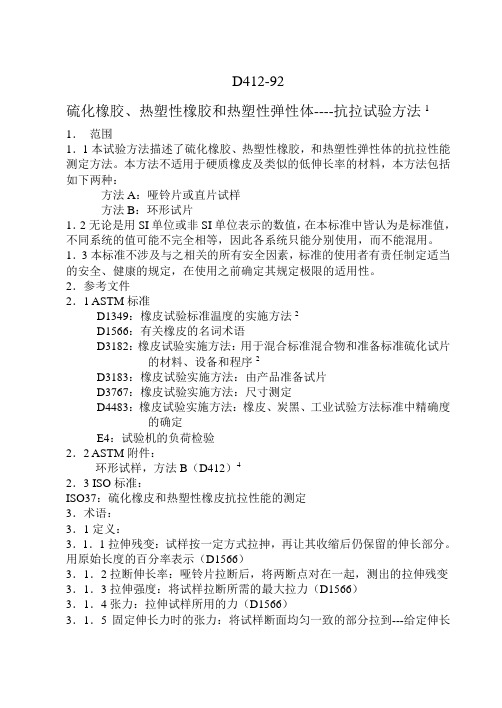
D412-92硫化橡胶、热塑性橡胶和热塑性弹性体----抗拉试验方法1 1.范围1.1本试验方法描述了硫化橡胶、热塑性橡胶,和热塑性弹性体的抗拉性能测定方法。
本方法不适用于硬质橡皮及类似的低伸长率的材料,本方法包括如下两种:方法A:哑铃片或直片试样方法B:环形试片1.2无论是用SI单位或非SI单位表示的数值,在本标准中皆认为是标准值,不同系统的值可能不完全相等,因此各系统只能分别使用,而不能混用。
1.3本标准不涉及与之相关的所有安全因素,标准的使用者有责任制定适当的安全、健康的规定,在使用之前确定其规定极限的适用性。
2.参考文件2.1 ASTM标准D1349:橡皮试验标准温度的实施方法2D1566:有关橡皮的名词术语D3182:橡皮试验实施方法:用于混合标准混合物和准备标准硫化试片的材料、设备和程序2D3183:橡皮试验实施方法:由产品准备试片D3767:橡皮试验实施方法:尺寸测定D4483:橡皮试验实施方法:橡皮、炭黑、工业试验方法标准中精确度的确定E4:试验机的负荷检验2.2 ASTM附件:环形试样,方法B(D412)42.3 ISO标准:ISO37:硫化橡皮和热塑性橡皮抗拉性能的测定3.术语:3.1定义:3.1.1拉伸残变:试样按一定方式拉抻,再让其收缩后仍保留的伸长部分。
用原始长度的百分率表示(D1566)3.1.2拉断伸长率:哑铃片拉断后,将两断点对在一起,测出的拉伸残变3.1.3拉伸强度:将试样拉断所需的最大拉力(D1566)3.1.4张力:拉伸试样所用的力(D1566)3.1.5固定伸长力时的张力:将试样断面均匀一致的部分拉到---给定伸长率所需的第力(D1566)3.1.6热塑性弹性体:橡皮类材料的一个分支,与传统的硫化橡皮不同,具有象热塑性材料一样的加工性能和再使用性能3.1.7最大伸长率:试样被拉断的伸长率3.1.8屈服点:张力—变形曲线上的一点(拉断处除外),此时张力随变形的变化率经过一零值,并可能变为负值。
ASTM-D412硫化橡胶和热塑性弹性体拉伸试验方法

名称:D 412—98a(2002年重新批准)硫化橡胶和热塑性弹性体——拉伸性能的标准实验方法希望采用本标准使用者在进行实验时,参照英文版本一起使用以便对译文提出建议并准确进行实验。
因此凡出现与英文版本相冲突,则以英文版本为准。
本标准已被国防部代理机构批准使用。
注释——9.2部分于2003.1被更新。
1. 范围1.1 这些方法是用来评估硫化橡胶和热塑性弹性体拉伸性能的程序。
这些方法不适用硬橡胶和相似硬度、低延伸率材料。
方法如下:方法A——哑铃状和直片状试样方法B——剪切环形状试样(不适用)注释1——这两种不同的方法不会产生同样的结果。
1.2 在本实验中,数值的表达不管是以SI还是非SI为单位,都认为是标准的。
在每一系统中数值可能不是等同的,因此必须单独使用每一系统,而不要合并这些数值。
1.3本标准没有对所有的安全问题进行详细的描述。
建立一个合适的安全和健康规则和决定其应用规则限制是使用者的责任。
2. 参考资料2.1 ASTM 标准:D 1349 橡胶标准实验温度准则D 1566 与橡胶相关的术语D 3182 混合标准化合物和准备标准硫化橡胶片的材料,设备和程序准则D 3183 实验用产品片准备准则D 3767 橡胶尺寸测量准则D 4483 橡胶和黑烟末工业中标准实验方法的测量精度准则E 4 实验机器力检查准则2.2 ASTM 附件:剪切环形试样,方法B (D 412)2.3 ISO 标准:ISO 37 硫化橡胶,热缩性橡胶张应力性能3.1 术语3.1 定义3.1.1 张力设置——在试样被伸展之后所保留的延长长度,允许以规定方式缩进,以占原始长度的百分比来表达。
(D 1566)3.1.2 破裂后张力设置——通过把两破裂的哑铃体橡胶片破裂点放在一起进行测量。
(D 1566)3.1.3 抗拉强度——施加给试样使其破裂的张应力。
(D 1566)3.1.4 张应力——伸展试样的力。
(D 1566)3.1.5 一定延伸率的张应力——使试样均匀横截面伸展到给定延伸时所需要的力。
ASTM D412标准中文版
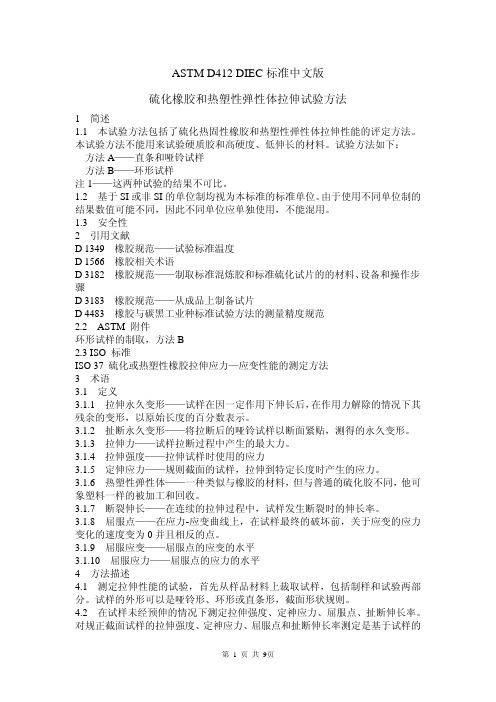
7 试样的选取 7.1 选取试样时应考虑以下及点 7.1.1 在制备和处理过程中,由流动引起的材料的各向异性和取向会影响拉伸性 能。因此在制备哑铃或直条形试样时,在知道压延方向的前提下,试样裁取的方 向应平行于压延方向。对于环形试样其通常是对取向特性作出一定的平均。 7.1.2 除有特别要求,对于热塑性橡胶或弹性体,试样应从厚度为 3.0±0.3mm 的 注射成型的试片上裁取,由其他厚度的试样得到的试验结果物可比性。试样应为 垂直和平行成型流动方向的两组。试片或试板的大小应能满足试验要求。 7.1.3 对于环形试样的伸长可以夹头的分离来测量,但对于试样半径宽度上的伸 长分布是不一致的。为了减少这影响,应试样宽度应小于环形试样的直径。 7.1.4 用直条形小、试样作普通的拉伸试验时,试样的破坏一般发生在夹头中。 因此尽当样品无法制取其他形状的样品时才使用直条形试样。 对于非破坏性的应 力应变或材料模量实验,才用直条形试样。 7.1.4 试样的尺寸大小取决于材料的要求、试验设备和试验用的样品试片。对于 低扯断伸长率的材料,为力提高测量伸长的精度可使用较长的试样。 8 试验设备的校准 8.1 对于测量精度型的测力计按规范 E 4 的过程 A 校准试验机,按照规范 E 4 的 7 和 18 节试验校准一个或多个力值点。对于摆锤式测力计按以下步骤校准: 8.1.1 将哑铃试样的一端放入试验机上夹头。 8.1.2 将下夹头移试验机从试验机上移开,也就是说试样的夹持机构在试验机的 上夹头。 8.1.3 在下夹头上安装钩子,以持试样下端 8.1.4 将一个以知重量的砝码挂到钩子上,这样就可以在试样的下夹具上临时的 施加一定质量(见注 2). 8.1.5 开启夹具移动的监视装置,在普通的试验中,保持其持续运行直到砝码自 由的悬挂于试样上。 8.1.6 如果圆盘或标尺(或者相当于是应力补偿的试验器)不能在规定的精度内 指示力值,应彻底检查设备的故障(例如轴或其他移动部件的摩擦) 。应确定下 夹头和钩子的质量也被计算在内。 8.1.7 在试验机的摩擦和其他故障被排除后,再对试验机进行校准,用以知的砝 码在试验机满量程约 10、20 和 50%处测量三点。如果平常试验时使用棘轮和棘 齿,在校准时也应使用他们。通过安装棘轮来检查摩擦。 注 3——应有防止砝码从试验机上掉落的装置。 8.2 可用弹簧来作大致的快速校准。 9 试验温度 9.1 除有其他规定,标准试验温度为 23±2℃。试样应至少在 23℃温度下调节 3 小时。如果材料受湿度的影响,试验前试样应在 50±5%R.H.的环境中调节 24 小 时以上。如在其他温度中试验应使用规范 D 1349 所列的温度。 9.2 如试验在高于 23℃的温度中进行,对于方法 A 试样应预热 10±2min;对于 方法 B 应预热 6±2min。在每次试验间隔前,分别将试样放如试验箱,这样所有 的试样会连续接受相同的预热时间。高温下的预热试验应受严格限制,以防止过 硫和热老化。 注 3——警告:除其他警告外,应使用绝热、绝冷的手套以保护手不受高低温的 伤害。在高温实验时应使用面罩以防止实验箱门打开时吸入有毒气体。
D41298a硫化橡胶和热塑性弹性体的标准测试方法――拉伸
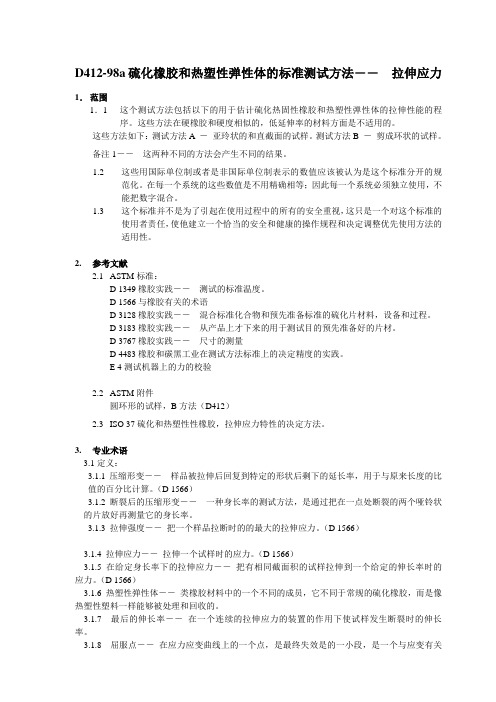
D412-98a硫化橡胶和热塑性弹性体的标准测试方法――拉伸应力1.范围1.1这个测试方法包括以下的用于估计硫化热固性橡胶和热塑性弹性体的拉伸性能的程序。
这些方法在硬橡胶和硬度相似的,低延伸率的材料方面是不适用的。
这些方法如下:测试方法A -亚玲状的和直截面的试样。
测试方法B -剪成环状的试样。
备注1――这两种不同的方法会产生不同的结果。
1.2这些用国际单位制或者是非国际单位制表示的数值应该被认为是这个标准分开的规范化。
在每一个系统的这些数值是不用精确相等;因此每一个系统必须独立使用,不能把数字混合。
1.3这个标准并不是为了引起在使用过程中的所有的安全重视,这只是一个对这个标准的使用者责任,使他建立一个恰当的安全和健康的操作规程和决定调整优先使用方法的适用性。
2. 参考文献2.1 ASTM标准:D 1349橡胶实践――测试的标准温度。
D 1566与橡胶有关的术语D 3128橡胶实践――混合标准化合物和预先准备标准的硫化片材料,设备和过程。
D 3183橡胶实践――从产品上才下来的用于测试目的预先准备好的片材。
D 3767橡胶实践――尺寸的测量D 4483橡胶和碳黑工业在测试方法标准上的决定精度的实践。
E 4测试机器上的力的校验2.2 ASTM附件圆环形的试样,B方法(D412)2.3 ISO 37硫化和热塑性性橡胶,拉伸应力特性的决定方法。
3. 专业术语3.1定义:3.1.1压缩形变――样品被拉伸后回复到特定的形状后剩下的延长率,用于与原来长度的比值的百分比计算。
(D 1566)3.1.2 断裂后的压缩形变――一种身长率的测试方法,是通过把在一点处断裂的两个哑铃状的片放好再测量它的身长率。
3.1.3 拉伸强度――把一个样品拉断时的的最大的拉伸应力。
(D 1566)3.1.4 拉伸应力――拉伸一个试样时的应力。
(D 1566)3.1.5 在给定身长率下的拉伸应力――把有相同截面积的试样拉伸到一个给定的伸长率时的应力。
ASTM D412硫化橡胶和热塑性弹性体拉伸试验方法
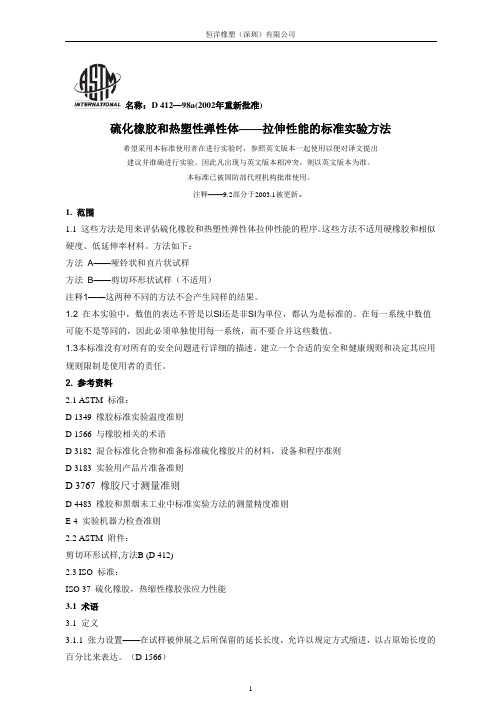
名称:D 412—98a(2002年重新批准)硫化橡胶和热塑性弹性体——拉伸性能的标准实验方法希望采用本标准使用者在进行实验时,参照英文版本一起使用以便对译文提出建议并准确进行实验。
因此凡出现与英文版本相冲突,则以英文版本为准。
本标准已被国防部代理机构批准使用。
注释——9.2部分于2003.1被更新。
1. 范围1.1 这些方法是用来评估硫化橡胶和热塑性弹性体拉伸性能的程序。
这些方法不适用硬橡胶和相似硬度、低延伸率材料。
方法如下:方法A——哑铃状和直片状试样方法B——剪切环形状试样(不适用)注释1——这两种不同的方法不会产生同样的结果。
1.2 在本实验中,数值的表达不管是以SI还是非SI为单位,都认为是标准的。
在每一系统中数值可能不是等同的,因此必须单独使用每一系统,而不要合并这些数值。
1.3本标准没有对所有的安全问题进行详细的描述。
建立一个合适的安全和健康规则和决定其应用规则限制是使用者的责任。
2. 参考资料2.1 ASTM 标准:D 1349 橡胶标准实验温度准则D 1566 与橡胶相关的术语D 3182 混合标准化合物和准备标准硫化橡胶片的材料,设备和程序准则D 3183 实验用产品片准备准则D 3767 橡胶尺寸测量准则D 4483 橡胶和黑烟末工业中标准实验方法的测量精度准则E 4 实验机器力检查准则2.2 ASTM 附件:剪切环形试样,方法B (D 412)2.3 ISO 标准:ISO 37 硫化橡胶,热缩性橡胶张应力性能3.1 术语3.1 定义3.1.1 张力设置——在试样被伸展之后所保留的延长长度,允许以规定方式缩进,以占原始长度的百分比来表达。
(D 1566)3.1.2 破裂后张力设置——通过把两破裂的哑铃体橡胶片破裂点放在一起进行测量。
(D 1566)3.1.3 抗拉强度——施加给试样使其破裂的张应力。
(D 1566)3.1.4 张应力——伸展试样的力。
(D 1566)3.1.5 一定延伸率的张应力——使试样均匀横截面伸展到给定延伸时所需要的力。
硫化橡胶拉伸弹性模量测定方法的研究
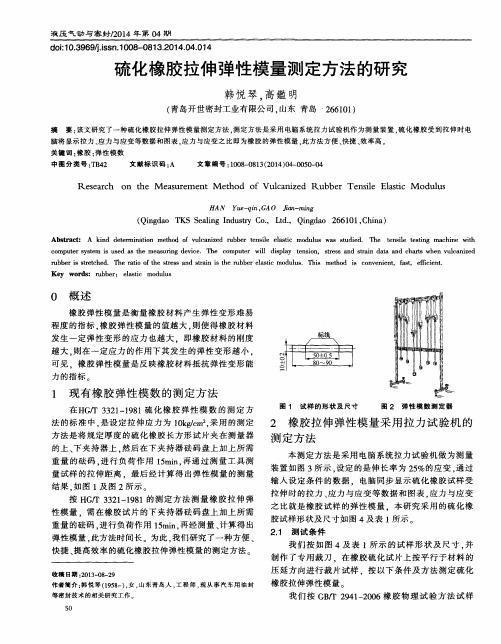
d o i : l O . 3 9 6 9 / j . i s s n . 1 0 0 8 - 0 8 1 3 . 2 0 1 4 . 0 4 . 0 1 4
硫化橡胶拉伸弹 性模 量测定 方法的研 究
韩悦琴 . 高镒 明
脑将显示拉力、 应 力 与 应 变等 数 据 和 图 表 , 应 力 与 应 变 之 比 即 为橡 胶 的 弹 性 模量 , 此 方 法 方便 、 快捷 、 效率高。
关键词 : 橡胶 ; 弹 性 模 数 中 图分 类号 : T B 4 2 文献标识码 : A 文章 编 号 : 1 0 0 8 — 0 8 1 3 ( 2 0 1 4 ) 0 4 ~ 0 0 5 0 — 0 4
r u b b e r i s s t r e t c h e d .T h e r a t i o o f t h e s t r e s s a n d s t r a i n i s t h e r u b b e r e l a s t i c mo d u l u s .T hi s me t h o d i s c o n v e n i e n t ,f a s t ,e ic f i e n t .
输 入设 定 条件 的数 据 .电脑 同步显 示 硫 化橡 胶 试 样 受
按 HG 厂 r 3 3 2 1 — 1 9 8 1的测 定 方 法 测 量 橡 胶 拉 伸 弹 性模 量 .需 在 橡胶 试 片 的下 夹 持 器 砝码 盘 上 加上 所 需 重 量 的砝 码 , 进行 负 荷作 用 1 5 a r i n , 再 经测 量 、 计 算得 出 弹性模 量 , 此方 法 时 间长 。为此 , 我 们研 究 了一 种方 便 、 快捷 、 提 高效 率 的硫化 橡胶 拉 伸弹性 模 量 的测 定方 法 。
硫化胶拉伸、阿克隆磨耗实验报告
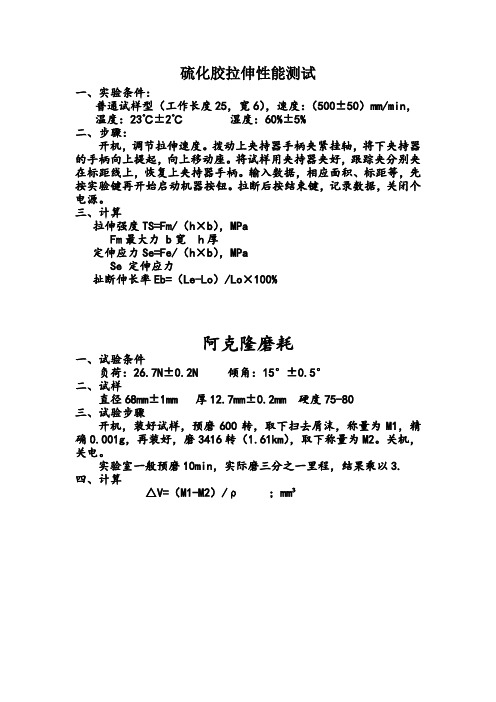
硫化胶拉伸性能测试
一、实验条件:
普通试样型(工作长度25,宽6),速度:(500±50)mm/min,温度:23℃±2℃湿度:60%±5%
二、步骤:
开机,调节拉伸速度。
拨动上夹持器手柄夹紧挂轴,将下夹持器的手柄向上提起,向上移动座。
将试样用夹持器夹好,跟踪夹分别夹在标距线上,恢复上夹持器手柄。
输入数据,相应面积、标距等,先按实验键再开始启动机器按钮。
拉断后按结束键,记录数据,关闭个电源。
三、计算
拉伸强度TS=Fm/(h×b),MPa
Fm最大力b宽h厚
定伸应力Se=Fe/(h×b),MPa
Se 定伸应力
扯断伸长率Eb=(Le-Lo)/Lo×100%
阿克隆磨耗
一、试验条件
负荷:26.7N±0.2N 倾角:15°±0.5°
二、试样
直径68mm±1mm 厚12.7mm±0.2mm 硬度75-80
三、试验步骤
开机,装好试样,预磨600转,取下扫去屑沫,称量为M1,精确0.001g,再装好,磨3416转(1.61km),取下称量为M2。
关机,关电。
实验室一般预磨10min,实际磨三分之一里程,结果乘以3. 四、计算
△V=(M1-M2)/ρ;mm³。
硫化橡胶或热塑性橡胶老化性能的测定 拉伸应力松弛试验(标准状

犌犅/犜 9871—2008/犐犛犗6914:2004
引 言
橡胶试样在给定伸长状态下,其应力随时间的变化是同时存 在 的 物 理 和 化 学 过 程 综 合 的 结 果。当 薄橡胶试样在高温下较长时间曝露于含氧环境时,以化学过程为 主。 因 此,在 这 种 条 件 下,经 过 一 段 时 间 的 曝 露 ,可 通 过 测 试 拉 伸 下 变 形 薄 橡 胶 试 样 的 应 力 变 化 ,测 定 橡 胶 的 老 化 性 能 。
3 仪 器
3.1 应力松弛仪(用于方法 A 或 B) 组成中有两个夹持器,能夹住处于固定伸长下的试样 而没有 滑 动(在 ±1% 以 内),以 及 测 量 和 记 录
试样上的力的装置。 夹持器的安装应使试样定位于老化箱中。力的测量系统可是 标 准 的 弹 簧 或 电 子 负 荷 传 感 器,或 其
出 ,在 标 准 实 验 室 温 度 下 测 量 应 力 。 附录 A 给出了这类测量所必需的校准明细表。 在单一的老化高温下的测量,可用于质量控制的目的,如耐热老化的程度。根据 GB/T20028 描述 的 方 法 ,在 一 系 列 温 度 下 进 行 测 量 以 预 测 长 期 的 老 化 性 能 ,可 用 于 研 究 和 开 发 的 目 的 。 在 三 个 方 法 之 间 无 法 互 相 推 算 ,所 用 的 方 法 取 决 于 试 验 目 的 。
2 规 范 性 引 用 文 件
下 列 文 件 中 的 条 款 通 过 本 标 准 的 引 用 而 成 为 本 标 准 的 条 款 ,凡 是 注 日 期 的 引 用 文 件 ,其 随 后 所 有 的 修 改 单 (不 包 括 勘 误 的 内 容 )或 修 订 版 均 不 适 用 于 本 标 准 ,然 而 ,鼓 励 根 据 本 标 准 达 成 协 议 的 各 方 研 究 是 否 可 使 用 这 些 文 件 的 最 新 版 本 。 凡 是 不 注 日 期 的 引 用 文 件 ,其 最 新 版 本 适 用 于 本 标 准 。
中华人民共和国国家标准硫化橡胶和热塑性橡胶拉伸性能的测定
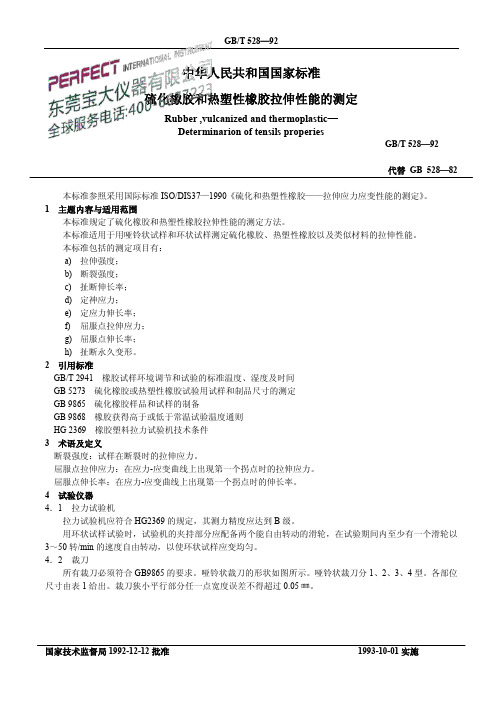
中华人民共和国国家标准硫化橡胶和热塑性橡胶拉伸性能的测定Rubber ,vulcanized and thermoplastic—Determinarion of tensils properiesGB/T 528—92代替GB 528—82本标准参照采用国际标准ISO/DIS37—1990《硫化和热塑性橡胶——拉伸应力应变性能的测定》。
1 主题内容与适用范围本标准规定了硫化橡胶和热塑性橡胶拉伸性能的测定方法。
本标准适用于用哑铃状试样和环状试样测定硫化橡胶、热塑性橡胶以及类似材料的拉伸性能。
本标准包括的测定项目有:a)拉伸强度;b)断裂强度;c)扯断伸长率;d)定神应力;e)定应力伸长率;f)屈服点拉伸应力;g)屈服点伸长率;h)扯断永久变形。
2 引用标准GB/T 2941 橡胶试样环境调节和试验的标准温度、湿度及时间GB 5273 硫化橡胶或热塑性橡胶试验用试样和制品尺寸的测定GB 9865 硫化橡胶样品和试样的制备GB 9868 橡胶获得高于或低于常温试验温度通则HG 2369 橡胶塑料拉力试验机技术条件3 术语及定义断裂强度:试样在断裂时的拉伸应力。
屈服点拉伸应力:在应力-应变曲线上出现第一个拐点时的拉伸应力。
屈服点伸长率:在应力-应变曲线上出现第一个拐点时的伸长率。
4 试验仪器4.1 拉力试验机拉力试验机应符合HG2369的规定,其测力精度应达到B级。
用环状试样试验时,试验机的夹持部分应配备两个能自由转动的滑轮,在试验期间内至少有一个滑轮以3~50转/min的速度自由转动,以使环状试样应变均匀。
4.2 裁刀所有裁刀必须符合GB9865的要求。
哑铃状裁刀的形状如图所示。
哑铃状裁刀分1、2、3、4型。
各部位尺寸由表1给出。
裁刀狭小平行部分任一点宽度误差不得超过0.05㎜。
国家技术监督局1992-12-12批准1993-10-01实施表1 哑铃状试样裁刀尺寸部位1型2型3型4型总长(最短L)115 75 35 50端头宽度W 25±1 12.5±1.0 6.0±0.5 8.5±0.5狭小平行部分长L n 33±2 25±1 12.0±0.5 16.0±1.0狭小平行部分宽W 6.0±0.40.0 4.0±0.1 2.0±0.1 4.0±0.1过渡边内径R0 14±0.1 8.0±0.5 3.0±0.1 7.5±0.5过渡边内径R i25±2 12.5±1.0 3.0±0.1 10.0±0.54.3 锥形测径计锥形测径计测量圆周直径的误差应小于0.01㎜。
ASTM D412-98a_chs硫化橡胶和热塑性弹性体——拉伸性能的标准实验方法

名称:D 412—98a(2002年重新批准)硫化橡胶和热塑性弹性体——拉伸性能的标准实验方法希望采用本标准使用者在进行实验时,参照英文版本一起使用以便对译文提出建议并准确进行实验。
因此凡出现与英文版本相冲突,则以英文版本为准。
本标准已被国防部代理机构批准使用。
注释——9.2部分于2003.1被更新。
1. 范围1.1 这些方法是用来评估硫化橡胶和热塑性弹性体拉伸性能的程序。
这些方法不适用硬橡胶和相似硬度、低延伸率材料。
方法如下:方法A——哑铃状和直片状试样方法B——剪切环形状试样注释1——这两种不同的方法不会产生同样的结果。
1.2 在本实验中,数值的表达不管是以SI还是非SI为单位,都认为是标准的。
在每一系统中数值可能不是等同的,因此必须单独使用每一系统,而不要合并这些数值。
1.3本标准没有对所有的安全问题进行详细的描述。
建立一个合适的安全和健康规则和决定其应用规则限制是使用者的责任。
2. 参考资料2.1 ASTM 标准:D 1349 橡胶标准实验温度准则D 1566 与橡胶相关的术语D 3182 混合标准化合物和准备标准硫化橡胶片的材料,设备和程序准则D 3183 实验用产品片准备准则D 3767 橡胶尺寸测量准则D 4483 橡胶和黑烟末工业中标准实验方法的测量精度准则E 4 实验机器力检查准则2.2 ASTM 附件:剪切环形试样,方法B (D 412)2.3 ISO 标准:ISO 37 硫化橡胶,热缩性橡胶张应力性能3.1 术语3.1 定义3.1.1 张力设置——在试样被伸展之后所保留的延长长度,允许以规定方式缩进,以占原始长度的百分比来表达。
(D 1566)3.1.2 破裂后张力设置——通过把两破裂的哑铃体橡胶片破裂点放在一起进行测量。
(D 1566)3.1.3 抗拉强度——施加给试样使其破裂的张应力。
(D 1566)3.1.4 张应力——伸展试样的力。
(D 1566)3.1.5 一定延伸率的张应力——使试样均匀横截面伸展到给定延伸时所需要的力。
ASTM D412-98a(2002)硫化橡胶、热塑橡胶和热塑合成橡胶的拉伸试验方法(中文版部分)

名称:D 412—98a(2002年重新批准)硫化橡胶和热塑性弹性体——拉伸性能的标准实验方法希望采用本标准使用者在进行实验时,参照英文版本一起使用以便对译文提出建议并准确进行实验。
因此凡出现与英文版本相冲突,则以英文版本为准。
本标准已被国防部代理机构批准使用。
注释——9.2部分于2003.1被更新。
1. 范围1.1 这些方法是用来评估硫化橡胶和热塑性弹性体拉伸性能的程序。
这些方法不适用硬橡胶和相似硬度、低延伸率材料。
方法如下:方法A——哑铃状和直片状试样方法B——剪切环形状试样注释1——这两种不同的方法不会产生同样的结果。
1.2 在本实验中,数值的表达不管是以SI还是非SI为单位,都认为是标准的。
在每一系统中数值可能不是等同的,因此必须单独使用每一系统,而不要合并这些数值。
1.3本标准没有对所有的安全问题进行详细的描述。
建立一个合适的安全和健康规则和决定其应用规则限制是使用者的责任。
2. 参考资料2.1 ASTM 标准:D 1349 橡胶标准实验温度准则D 1566 与橡胶相关的术语D 3182 混合标准化合物和准备标准硫化橡胶片的材料,设备和程序准则D 3183 实验用产品片准备准则D 3767 橡胶尺寸测量准则D 4483 橡胶和黑烟末工业中标准实验方法的测量精度准则E 4 实验机器力检查准则2.2 ASTM 附件:剪切环形试样,方法B (D 412)2.3 ISO 标准:ISO 37 硫化橡胶,热缩性橡胶张应力性能3.1 术语3.1 定义3.1.1 张力设置——在试样被伸展之后所保留的延长长度,允许以规定方式缩进,以占原始长度的百分比来表达。
(D 1566)3.1.2 破裂后张力设置——通过把两破裂的哑铃体橡胶片破裂点放在一起进行测量。
(D 1566)3.1.3 抗拉强度——施加给试样使其破裂的张应力。
(D 1566)3.1.4 张应力——伸展试样的力。
(D 1566)3.1.5 一定延伸率的张应力——使试样均匀横截面伸展到给定延伸时所需要的力。
硫化橡胶和热塑性橡胶拉伸性能的测定
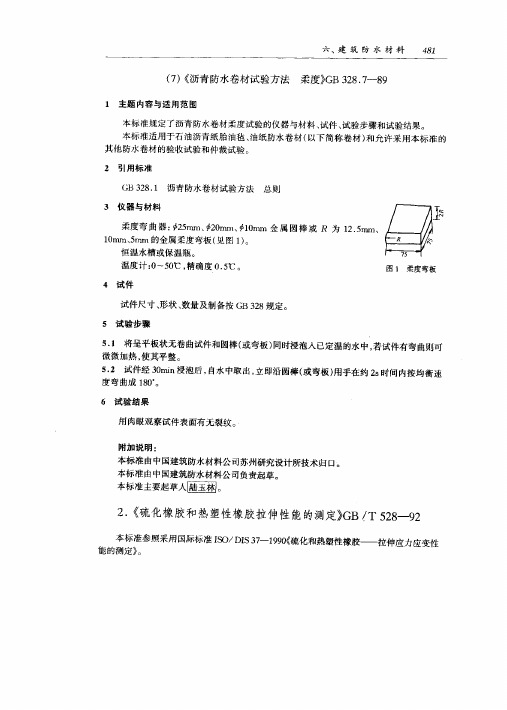
41 8
() 沥青防水卷材试验方法 柔度》 B . 9 7 G 387 2卷材柔度试验的仪器与材料、 试件、 试验步骤和试验结果。 本标准适用于石油沥青纸胎油毡、 油纸防水卷材( 以下简称卷材) 和允许采用本标准的 其他防水卷材的验收试验和仲裁试验。
m l no
开动试验机, 监视二滑轮距离和应力的变化。 按试验要求, 记录下列项目中的几项或全
部:
a 试样拉伸到给定伸长率时的力值; . b 屈服点对应的力值; . ‘ 试样拉伸至断裂过程中出现的最大力值; . d 试样拉伸到给定应力时, . 二滑轮中心距; 。 试样拉伸至屈服点时, . 二滑轮的中心距; f 试样断裂时, . 二滑轮的中心距。
1 ) mia 2 m 0 m/ n
开动试验机, 拉伸试样并跟踪试样的 标记, 按试验要求记录下列项目 中的几项或全部: u 试样拉伸到给定伸长率时的力值; . b 屈服点对应的力值; . : 试样拉伸至断裂过程中出现的最大力值; . d 试样断裂时的力值; 。 试样拉伸至给定应力时的伸长率; . 了 屈服点对应的伸长率; . 9 试样断裂时的伸长率。 . 测扯断永 久变形时, 应将断裂后的 试样放置3 i 再把断裂的两部分吻合在一起, mn , 用精 度为 05u 的量具测量吻合好的试样的标距并计算永久变形值。 . n n 对于在试样狭小平行部分( 中的L ) 图1 之外断裂的试样, 该试样的试验结果应予作废 并需补片重复测试。 ,2 采用环状试样 . 将环状试样以最小的张力置于两个滑轮上, 滑轮的移动速度应调至(0 1 m / 50 0 m 5)
环状试样的平均周长按式() 2计算:
L = ( W, , 二D+ ) () 2 式中 L — 环状试样的 , 平均周长(m ; m ) D — 环状试样的内 m ) 径( m ; W, 环状试样的径向 — 宽度( m . m )
硫化橡胶或热塑性橡胶拉伸应力应变性能试验

1、检测标准
《硫化橡胶或热塑性橡胶拉伸应力应变性能的测定》GB/T528/2009(代1998)
2、范围
本标准适用于测定硫化橡胶或热塑性橡胶的性能,如拉伸强度、拉断伸长率、定伸应力、定应力伸长率、屈服点拉伸应力和屈服点伸长率。而屈服点拉伸应力和应变的测量只适用于某些热塑性橡胶和某些其他胶料。
20.0±0.5
20.0±0.5
10±0.5
10.0±0.5
试样厚度mm
2.0±0.2
2.0±0.2
2.0±0.2
2.0±0.2
1.0±0.1
试验长度不应超过试样狭窄部位的长度(下表2尺寸C)
5.2.2哑铃状试样裁刀尺寸
尺寸
1型
1A型
2型
3型
4型
A总长度(最小)mm
115
100
75
50
35
B端部宽度mm
所需应力对应的力值Fe按公式计算以N表示Fe=SeW t
屈服点拉伸应力按公式计算以Mpa表示Sy=Fy/W t
屈服点伸长率Ey按公司计算,以%表示Ey=100(Ly/L0)/ L0
公式中所使用的符号意义如下:
Fb—断裂时记录的力,单位N
Fe-给定应力时记录的力,单位N
Fm—记录的最大的力,单位N
Fy—屈服点时记录的最大的力,单位N
4.9屈服点伸长率Ey应力/应变曲线上出现应变进一步增加而应力不增加的第一个点对应的拉伸应变。
4.10哑铃关试样的试验长度哑铃状试样狭窄部分的长度内,用于测量伸长率的基准标线之间的初始距离。
4、原理
在动夹持器或滑轮恒速移动的拉力试验机上,将哑铃关或环状标准试样进行拉伸。按要求记录试样在不断拉伸过程中和当其断裂时所需的力和伸长率的值。
中华人民共和国国家标准硫化橡胶和热塑性橡胶拉伸性能的测定

中华人民共和国国家标准硫化橡胶和热塑性橡胶拉伸性能的测定Rubber ,vulcanized and thermoplastic—Determinarion of tensils properiesGB/T 528—92代替GB 528—82本标准参照采用国际标准ISO/DIS37—1990《硫化和热塑性橡胶——拉伸应力应变性能的测定》。
1 主题内容与适用范围本标准规定了硫化橡胶和热塑性橡胶拉伸性能的测定方法。
本标准适用于用哑铃状试样和环状试样测定硫化橡胶、热塑性橡胶以及类似材料的拉伸性能。
本标准包括的测定项目有:a)拉伸强度;b)断裂强度;c)扯断伸长率;d)定神应力;e)定应力伸长率;f)屈服点拉伸应力;g)屈服点伸长率;h)扯断永久变形。
2 引用标准GB/T 2941 橡胶试样环境调节和试验的标准温度、湿度及时间GB 5273 硫化橡胶或热塑性橡胶试验用试样和制品尺寸的测定GB 9865 硫化橡胶样品和试样的制备GB 9868 橡胶获得高于或低于常温试验温度通则HG 2369 橡胶塑料拉力试验机技术条件3 术语及定义断裂强度:试样在断裂时的拉伸应力。
屈服点拉伸应力:在应力-应变曲线上出现第一个拐点时的拉伸应力。
屈服点伸长率:在应力-应变曲线上出现第一个拐点时的伸长率。
4 试验仪器4.1 拉力试验机拉力试验机应符合HG2369的规定,其测力精度应达到B级。
用环状试样试验时,试验机的夹持部分应配备两个能自由转动的滑轮,在试验期间内至少有一个滑轮以3~50转/min的速度自由转动,以使环状试样应变均匀。
4.2 裁刀所有裁刀必须符合GB9865的要求。
哑铃状裁刀的形状如图所示。
哑铃状裁刀分1、2、3、4型。
各部位尺寸由表1给出。
裁刀狭小平行部分任一点宽度误差不得超过0.05㎜。
国家技术监督局1992-12-12批准1993-10-01实施表1 哑铃状试样裁刀尺寸部位1型2型3型4型总长(最短L)115 75 35 50端头宽度W 25±1 12.5±1.0 6.0±0.5 8.5±0.5狭小平行部分长L n 33±2 25±1 12.0±0.5 16.0±1.0狭小平行部分宽W 6.0±0.40.0 4.0±0.1 2.0±0.1 4.0±0.1过渡边内径R0 14±0.1 8.0±0.5 3.0±0.1 7.5±0.5过渡边内径R i25±2 12.5±1.0 3.0±0.1 10.0±0.54.3 锥形测径计锥形测径计测量圆周直径的误差应小于0.01㎜。
- 1、下载文档前请自行甄别文档内容的完整性,平台不提供额外的编辑、内容补充、找答案等附加服务。
- 2、"仅部分预览"的文档,不可在线预览部分如存在完整性等问题,可反馈申请退款(可完整预览的文档不适用该条件!)。
- 3、如文档侵犯您的权益,请联系客服反馈,我们会尽快为您处理(人工客服工作时间:9:00-18:30)。
D 412 硫化橡胶和热塑性弹性体拉伸试验方法1简述1.1本试验方法包括了硫化热固性橡胶和热塑性弹性体拉伸性能的评定方法。
本试验方法不能用来试验硬质胶和高硬度、低伸长的材料。
试验方法如下:方法A——直条和哑铃试样方法B——环形试样注1——这两种试验的结果不可比。
1.2 基于SI或非SI的单位制均视为本标准的标准单位。
由于使用不同单位制的结果数值可能不同,因此不同单位应单独使用,不能混用。
1.3 安全性2 引用文献D 1349 橡胶规范——试验标准温度D 1566 橡胶相关术语D 3182 橡胶规范——制取标准混炼胶和标准硫化试片的的材料、设备和操作步骤D 3183 橡胶规范——从成品上制备试片D 4483 橡胶与碳黑工业种标准试验方法的测量精度规范2.2 ASTM 附件环形试样的制取,方法B2.3 ISO 标准ISO 37 硫化或热塑性橡胶拉伸应力—应变性能的测定方法3 术语3.1 定义3.1.1 拉伸永久变形——试样在因一定作用下伸长后,在作用力解除的情况下其残余的变形,以原始长度的百分数表示。
3.1.2 扯断永久变形——将拉断后的哑铃试样以断面紧贴,测得的永久变形。
3.1.3 拉伸力——试样拉断过程中产生的最大力。
3.1.4 拉伸强度——拉伸试样时使用的应力3.1.5 定伸应力——规则截面的试样,拉伸到特定长度时产生的应力。
3.1.6 热塑性弹性体——一种类似与橡胶的材料,但与普通的硫化胶不同,他可象塑料一样的被加工和回收。
3.1.7 断裂伸长——在连续的拉伸过程中,试样发生断裂时的伸长率。
3.1.8 屈服点——在应力-应变曲线上,在试样最终的破坏前,关于应变的应力变化的速度变为0并且相反的点。
3.1.9 屈服应变——屈服点的应变的水平屈服应力——屈服点的应力的水平4 方法描述4.1 测定拉伸性能的试验,首先从样品材料上裁取试样,包括制样和试验两部分。
试样的外形可以是哑铃形、环形或直条形,截面形状规则。
4.2 在试样未经预伸的情况下测定拉伸强度、定神应力、屈服点、扯断伸长率。
对规正截面试样的拉伸强度、定神应力、屈服点和扯断伸长率测定是基于试样的原始截面积。
4.3 拉伸永久变形和扯断永久变形,测量试样拉伸后经按规定方法回缩后的形变。
5 重点与应用5.1 本试验涉及的材料或产品在实际应用过程中必须受拉伸力作用。
本试验即为测定此种拉伸特性。
但拉伸性能不直接代表产品最终使用的全部情况,因为在实际使用中产品需含盖较广的潜在使用情况。
5.2 拉伸性能与材料和试验条件(拉伸速度、试验温度和湿度、试样几何外形、试验前调节情况等)有关。
因此,尽在相同条件下材料的试验结果才有可比性。
5.3 试验温度和拉伸速度对拉伸性能影响较显著,需严格控制。
且影响随材料不同而不同。
5.4 拉伸永久变形代表了试样的残余变形,他表示试样经拉伸和回缩后部分的永久变形和部分的回复。
因此,拉伸和回缩过程(和其他试验条件)必须受严格控制,以保证结果的可比性。
6 设备6.1 拉力机——拉力试验机应有电力驱动机构以保证试样夹头的分离速度恒定为500±50mm/min,最小行程为750mm(见注1)。
试验机应有一套适合的测力计和读数记录系统,以保证测量的力偏差在±2%以内。
如果试验机的量程不能改变(例如摆锤式测力计),那么试样断裂时测得力的偏差在测力计满量程的±2%,且测量的最小力的精度为10%。
如果测力计在直接测量拉伸应力时有自动补偿功能,那么在测量过程中应将其对试样结截面积的补偿功能关闭。
记录装置对力的测量速度应足够快,并且在试样破坏的整个过程中应保证需要的精度。
如果试验机没有记录装置,那么应该有一个指示器用来指示拉伸过程中的最大力值。
试验体系中应能测量伸长,且最小的增量为10%。
注1——如果使用的拉伸速度为1000±100mm/min应在试验报告中注明。
如有疑义,试验应在500mm/min的速度下重新进行。
6.2 高低温试验箱——试验箱应满足以下要求:6.2.1 试验箱内在夹头和轴的位置上应有环绕的热流,环绕速度为1到2m/s,温度保持在要求温度偏差的2℃范围内。
6.2.2 应用校准过的测温装置在夹头和轴的附近测量实际温度。
6.2.3 试验箱应有排气通风装置,以将在高温中(试样)释放的气体排出到大气中。
6.2.4 在试验前试样应垂直的放置在夹头和轴附近接受调节。
试样不应相互接触或与试验箱壁接触除了由环绕空气的搅动引起的瞬间的接触。
6.2.5 将夹头适宜的安放以方便在高低温的环境中操作。
这样在向夹头中放置哑铃或直条试样时尽可能缩短时间,以减少试验箱温度的变化。
6.2.6 测力计应适宜在试验温度下工作,或则与试验箱绝热良好。
6.2.7 试验箱中应配有伸长测量装置。
如果用尺来测量试样标距的伸长,尺应在靠近夹头移动路径的位置平行于标距放置,并可从试验箱外进行控制。
6.3 测厚计——厚度计应符合规范D 3767(方法A)的要求。
对于环形试样,见本试验方法14.10条。
6.4 拉伸永久变形的测量——使用如6.1中所述或如图1示的试验设备。
秒表或其他计时装置的量程应大于30min,尺或其他测量伸长的装置的测量精度应在1%内。
7 试样的选取7.1 选取试样时应考虑以下及点,由流动引起的材料的各向异性和取向会影响拉伸性能。
因此在制备哑铃或直条形试样时,在知道压延方向的前提下,试样裁取的方向应平行于压延方向。
对于环形试样其通常是对取向特性作出一定的平均。
7.1.2 除有特别要求,对于热塑性橡胶或弹性体,试样应从厚度为3.0±0.3mm的注射成型的试片上裁取,由其他厚度的试样得到的试验结果物可比性。
试样应为垂直和平行成型流动方向的两组。
试片或试板的大小应能满足试验要求。
7.1.3 对于环形试样的伸长可以夹头的分离来测量,但对于试样半径宽度上的伸长分布是不一致的。
为了减少这影响,应试样宽度应小于环形试样的直径。
7.1.4 用直条形小、试样作普通的拉伸试验时,试样的破坏一般发生在夹头中。
因此尽当样品无法制取其他形状的样品时才使用直条形试样。
对于非破坏性的应力应变或材料模量实验,才用直条形试样。
7.1.5 试样的尺寸大小取决于材料的要求、试验设备和试验用的样品试片。
对于低扯断伸长率的材料,为力提高测量伸长的精度可使用较长的试样。
8 试验设备的校准8.1 对于测量精度型的测力计按规范E 4的过程A校准试验机,按照规范E 4的7和18节试验校准一个或多个力值点。
对于摆锤式测力计按以下步骤校准:8.1.1 将哑铃试样的一端放入试验机上夹头。
8.1.2 将下夹头移试验机从试验机上移开,也就是说试样的夹持机构在试验机的上夹头。
8.1.3 在下夹头上安装钩子,以持试样下端8.1.4 将一个以知重量的砝码挂到钩子上,这样就可以在试样的下夹具上临时的施加一定质量(见注2).8.1.5 开启夹具移动的监视装置,在普通的试验中,保持其持续运行直到砝码自由的悬挂于试样上。
8.1.6 如果圆盘或标尺(或者相当于是应力补偿的试验器)不能在规定的精度内指示力值,应彻底检查设备的故障(例如轴或其他移动部件的摩擦)。
应确定下夹头和钩子的质量也被计算在内。
8.1.7 在试验机的摩擦和其他故障被排除后,再对试验机进行校准,用以知的砝码在试验机满量程约10、20和50%处测量三点。
如果平常试验时使用棘轮和棘齿,在校准时也应使用他们。
通过安装棘轮来检查摩擦。
注2——应有防止砝码从试验机上掉落的装置。
8.2 可用弹簧来作大致的快速校准。
9 试验温度9.1 除有其他规定,标准试验温度为23±2℃。
试样应至少在23℃温度下调节3小时。
如果材料受湿度的影响,试验前试样应在50±5%R.H.的环境中调节24小时以上。
如在其他温度中试验应使用规范D 1349所列的温度。
9.2 如试验在高于23℃的温度中进行,对于方法A试样应预热10±2min;对于方法B应预热6±2min。
在每次试验间隔前,分别将试样放如试验箱,这样所有的试样会连续接受相同的预热时间。
高温下的预热试验应受严格限制,以防止过硫和热老化。
注3——警告:除其他警告外,应使用绝热、绝冷的手套以保护手不受高低温的伤害。
在高温实验时应使用面罩以防止实验箱门打开时吸入有毒气体。
9.3 对于低温试验,试样应至少预冷10min。
试验方法A——直条和哑铃试样10 设备10.1裁刀——裁刀的外形和尺寸应符合图2所示。
裁刀中狭窄部分的内侧应于裁刀端面面垂直,并且至少有从裁刀端面起5mm长的部分经过抛光。
裁刀外形应保持不变,并无缺损。
(见注4)注4——可通过观察试样断裂点来确定裁刀的情况。
将断裂试样从夹头上取下,沿断裂面拼合,观察试样破坏是否发生在相同的位置。
如果破坏发生在相同位置,表示裁刀在此位置可能变钝、缺损或弯曲。
10.2 作标线——在试样上画两条标线用来测量伸长合应变的称为作标线(见注5)。
标线器应包括一个平板,平板上有两个相互平行的凸起。
凸起的表面(与平板表面平行)应有狭长。
